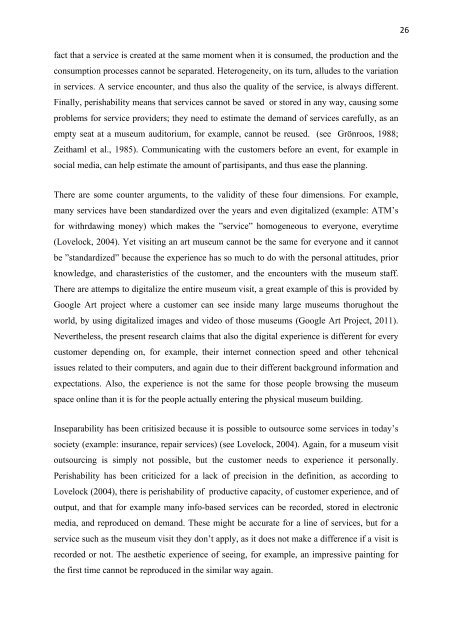Is there more to it than posting a status update?
Is there more to it than posting a status update?
Is there more to it than posting a status update?
Create successful ePaper yourself
Turn your PDF publications into a flip-book with our unique Google optimized e-Paper software.
fact that a service is created at the same moment when <strong>it</strong> is consumed, the production and the<br />
consumption processes cannot be separated. Heterogene<strong>it</strong>y, on <strong>it</strong>s turn, alludes <strong>to</strong> the variation<br />
in services. A service encounter, and thus also the qual<strong>it</strong>y of the service, is always different.<br />
Finally, perishabil<strong>it</strong>y means that services cannot be saved or s<strong>to</strong>red in any way, causing some<br />
problems for service providers; they need <strong>to</strong> estimate the demand of services carefully, as an<br />
empty seat at a museum audi<strong>to</strong>rium, for example, cannot be reused. (see Grönroos, 1988;<br />
Ze<strong>it</strong>haml et al., 1985). Communicating w<strong>it</strong>h the cus<strong>to</strong>mers before an event, for example in<br />
social media, can help estimate the amount of partisipants, and thus ease the planning.<br />
There are some counter arguments, <strong>to</strong> the valid<strong>it</strong>y of these four dimensions. For example,<br />
many services have been standardized over the years and even dig<strong>it</strong>alized (example: ATM’s<br />
for w<strong>it</strong>hrdawing money) which makes the ”service” homogeneous <strong>to</strong> everyone, everytime<br />
(Lovelock, 2004). Yet vis<strong>it</strong>ing an art museum cannot be the same for everyone and <strong>it</strong> cannot<br />
be ”standardized” because the experience has so much <strong>to</strong> do w<strong>it</strong>h the personal att<strong>it</strong>udes, prior<br />
knowledge, and charasteristics of the cus<strong>to</strong>mer, and the encounters w<strong>it</strong>h the museum staff.<br />
There are attemps <strong>to</strong> dig<strong>it</strong>alize the entire museum vis<strong>it</strong>, a great example of this is provided by<br />
Google Art project where a cus<strong>to</strong>mer can see inside many large museums thorughout the<br />
world, by using dig<strong>it</strong>alized images and video of those museums (Google Art Project, 2011).<br />
Nevertheless, the present research claims that also the dig<strong>it</strong>al experience is different for every<br />
cus<strong>to</strong>mer depending on, for example, their internet connection speed and other tehcnical<br />
issues related <strong>to</strong> their computers, and again due <strong>to</strong> their different background information and<br />
expectations. Also, the experience is not the same for those people browsing the museum<br />
space online <strong>than</strong> <strong>it</strong> is for the people actually entering the physical museum building.<br />
Inseparabil<strong>it</strong>y has been cr<strong>it</strong>isized because <strong>it</strong> is possible <strong>to</strong> outsource some services in <strong>to</strong>day’s<br />
society (example: insurance, repair services) (see Lovelock, 2004). Again, for a museum vis<strong>it</strong><br />
outsourcing is simply not possible, but the cus<strong>to</strong>mer needs <strong>to</strong> experience <strong>it</strong> personally.<br />
Perishabil<strong>it</strong>y has been cr<strong>it</strong>icized for a lack of precision in the defin<strong>it</strong>ion, as according <strong>to</strong><br />
Lovelock (2004), <strong>there</strong> is perishabil<strong>it</strong>y of productive capac<strong>it</strong>y, of cus<strong>to</strong>mer experience, and of<br />
output, and that for example many info-based services can be recorded, s<strong>to</strong>red in electronic<br />
media, and reproduced on demand. These might be accurate for a line of services, but for a<br />
service such as the museum vis<strong>it</strong> they don’t apply, as <strong>it</strong> does not make a difference if a vis<strong>it</strong> is<br />
recorded or not. The aesthetic experience of seeing, for example, an impressive painting for<br />
the first time cannot be reproduced in the similar way again.<br />
26















